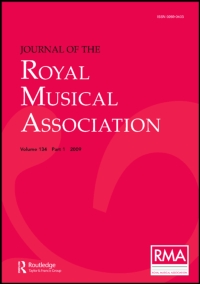No CrossRef data available.
Article contents
The Philosophy of the Higher Beauty of Music
Published online by Cambridge University Press: 01 January 2020
Extract
In endeavouring to discover the larger foundations of the influence of music we have had to travel somewhat far into the region of hypothesis; but there are several striking features of its influence which rest on causes closer at hand: in attempting to explain these we stand on firmer ground. One of these features has been already touched upon—namely, the influence of those effects which arise out of the fact that the musical faculties and sensibilities are, so to speak, grafted on those involved in utterance and hearing; the others may, I believe, be explained from a point of view which, whether it be original or not, I have, I believe, taken up independently—namely, the position of hearing among the senses.
- Type
- Research Article
- Information
- Copyright
- Copyright © Royal Musical Association, 1899
References
∗ For instance, the white of this paper by candle-light is very different from what it is by day-light, but our conception is the same in both circumstances.Google Scholar
∗ This appears less improbable when we consider the very close association that exists between auditory sensations and the voice. Dr. M. Foster says: “They (auditory sensations) are in a way essential to the very utterance of the voice; the dumbness which is so conspicuous a concomitant of congenital deafness is in most cases due not to deficiency in the muscular apparatus or even in the nervous mechanism on what we may call its motor side, but to the lack of afferent (incoming) impulses from the auditory nerve. And in popular language we recognise this dependence of the management of the laryngeal muscles on auditory sensations when we talk of such or such one as ‘having no ear.’” Inversely, then, may not auditory sensations when operating alone imbue some feeling of laryngeal action ?Google Scholar
∗ It is probably because the muscular actions involved are all internal, do not embrace movements connected with the ear itself, and are registered in that abstract world of sound from which we do not in the main get our impressions of outward things, that the ideas of form which they suggest are partial and impalpable.Google Scholar
∗ See “note” to this paper.Google Scholar


